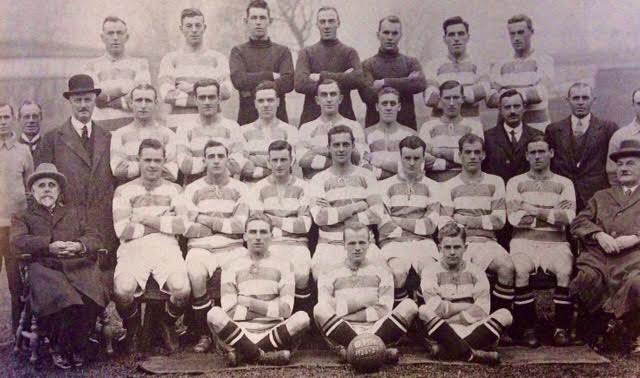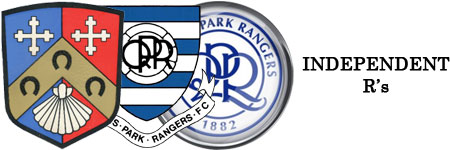Team: Hebden, Sweetman, Pierce, McAlister, Eggleton, Gough, Charlesworth, Mustard, Goddard, Middleton, Lofthouse
Attendance: 8,187
Rangers travelled to Highfield Road on 22nd January 1927. Under the title: ‘Mixed Sport at Highfield Road’, the following match report appeared in the Coventry Evening Telegraph later that day:
‘With three inches of snow on the ground and only the essential lines clear, Highfield Road presented a peculiar scene, when Queen’s Park Rangers and City lined out there this afternoon.
For some reason difficult to imagine, the goalposts had been painted a dark blue, a colour which stood out in bright contrast until the crowd assembled behind them, then they merged themselves into the dark background.
There may have been 8,000 spectators present when the City won the toss, but a larger gathering could scarcely have been anticipated, and it soon became obvious that the football was to be farcical.
Any attempt at a ground pass saw the ball pulled up with surprising suddenness, and it was some time before the teams acclimatised themselves to the conditions.
There was one clever centre by Breslin, which failed to find a “customer” and Gardiner also found no one waiting when he dropped a free kick into the goalmouth.
Heathcote was going through nicely when his pass appeared to be handled, but the referee was not in sympathy with the general appeal.
It was the big man’s ground today, and men like McClure, Brown and Gardiner were overcoming the difficulties with equanimity, but the City’s light forwards on both wings, appeared to find it impossible to lift their feet out of the snow.
On the whole the City were having the best of matters, but the open space in front of goal was proving very intriguing. The ball would appear to have lost its pace upon reaching the cleared space, and then would suddenly shoot across it, as though kicked by some unseen foot.
It was such an event as this which completely puzzled Herbert on one occasion, but just afterwards the City man lost two fine chances.
In one case he took too long to master the ball in the heavy snow, and in another tried to work too close to Hebden, who ran out and baulked him.
At Newton’s end, Goddard, who had been drawing attention to himself as the Queen’s Park leader, was lying right up the field in the hope of snapping up straight passes, but Randle and Tinning were watching the offside possibilities, and caught him napping repeatedly.
At the same time he managed to elude them once, and from a right-wing pass sent a header perilously near the far upright.
Lofthouse made one, very pretty run, and tested Newton, who had to obtain McClure’s assistance to clear a dangerous situation. The Rangers were very quick to adapt themselves to the snow-game.
They lifted the ball well clear of the ground, and appeared to have twice the speed of the City, who were doing far too much short passing.
The Rangers’ backs were especially at home in the going, and they robbed Breslin and Dunn of some fine openings by charging across goal at speeds which altogether upset the calculations of the snow-ridden City lightweights.
The Rangers developed some dangerous attacks, fortunately for the City, spoilt by poor shooting, but both Lofthouse and Charlesworth got past the City backs in a manner which showed that speedy attack was possible.
Quite the best City effort came when Herbert beat McAlister and brought Hebden to his knees to stop a beautiful drive. He was quickly at it again, for Breslin tested him well, and at last the Bantams appeared to be getting into their stride.

Half-time: 0-0. Quite the most lively scenes which the game produced were enacted while the match was actually in adjournment. As soon as the teams left the field a score of snow battles developed on as many battlefields.
The air was thick with snowballs, and practically nobody was exempt. As the players resumed they met a hail of snow, and even the constables on touch-line duty kept a wary eye upon the crowds.
The City appeared to realise the need for loose passing, and came out to make ground well.
Herbert was brought down in the penalty area at the termination of the most promising effort. The referee refused to “oblige” with a penalty, and a moment later the Bedworth man came on again.
He worked clean through and shot towards the side of the net. Hebden made a dive for the ball, and slid for yards on the icy ground in making his clearance.
Another opening came Herbert’s way but he had to use his right foot and failed to find the pace.
Then it was Ferguson’s turn. His first effort was particularly soft, but he tried again, and Hebden made a fine save in conceding a corner.
At the City end Lofthouse had an open goal, but shot wide; the ball was soon back at the Rangers’ end, for Herbert to hit an upright after taking the ball to rather a wide angle.
It was all the City’s game from that time onwards, and Hebden had to do the work of several men.
Some amusement was caused when a linesman re-echoed the snowball comedy by stopping the game to complain to the referee, who placed a policeman on special snowball duty.
Soon afterwards a free kick was awarded for a foul on Dunn, and as McClure was about to take the shot one of the Rangers impeded him. Alec was so annoyed that he threw what appeared to be a small lump of snow at the offender – obviously more in fun than anger.
There was a short committee meeting between the referee and McClure, the subject of which was presumably snowballs.
Returning to serious football, the City renewed their attacks. Brown tested Hebden with a beauty, and the Rangers’ goalkeeper continued to survive an avalanche of shots, the majority of them not being of a terrifying character.
In fact, few of them were as good as that which Middleton essayed at the City end during a visiting breakaway. It hit an upright at speed.
At 60 minutes the City went ahead with a beautiful goal, arising from one of those clever bits of work which Dunn occasionally shows. A passing movement of the triangular style between Ferguson, Herbert, and Gardiner, resulted in the latter sending forward to a point about five yards from the near upright.
Dunn was there with his back to goal, and as the ball dropped on to his foot he swung half round and swerved it into the net in beautiful fashion. From this time onwards it appeared to be only a matter of how many more goals the City would score.
Apart from occasional breakaways, which the defence dealt with effectively, the Rangers were largely confined to defence, and they had Hebden to thank repeatedly.
There was an occasion when Ferguson got going, prettily tricked Sweetman, and centred to Heathcote in the goalmouth. It seemed a certainty, but as the Bantam headed at speed, Hebden anticipated the move to a fraction, and cleared yet again.
The snow was getting firmer now, and to some extent the City lightweights were shaking off their handicaps.
Hebden was giving a display which will not be readily forgotten. He appeared to have Herbert weighed up, for after a brilliant bout of passing, Ferguson sent his partner through and the inside man slammed hard at goal.
It was a fine drive, but Hebden was there again, and the crowd cheered the gallant goalkeeper to the echo.
The City’s short passing game was coming into its own, and Heathcote, Ferguson and Herbert went off again.
Ferguson took the shot, and sent the ball skimming towards the far upright well out of reach, but, to the obvious surprise of the spectators, the ball swerved narrowly past the outside of the upright.’
Two weeks later Rangers defeated Charlton Athletic 2-1 at Loftus Road.
Steve Russell
(My thanks to Colin Woodley for uncovering this wonderful match report)
